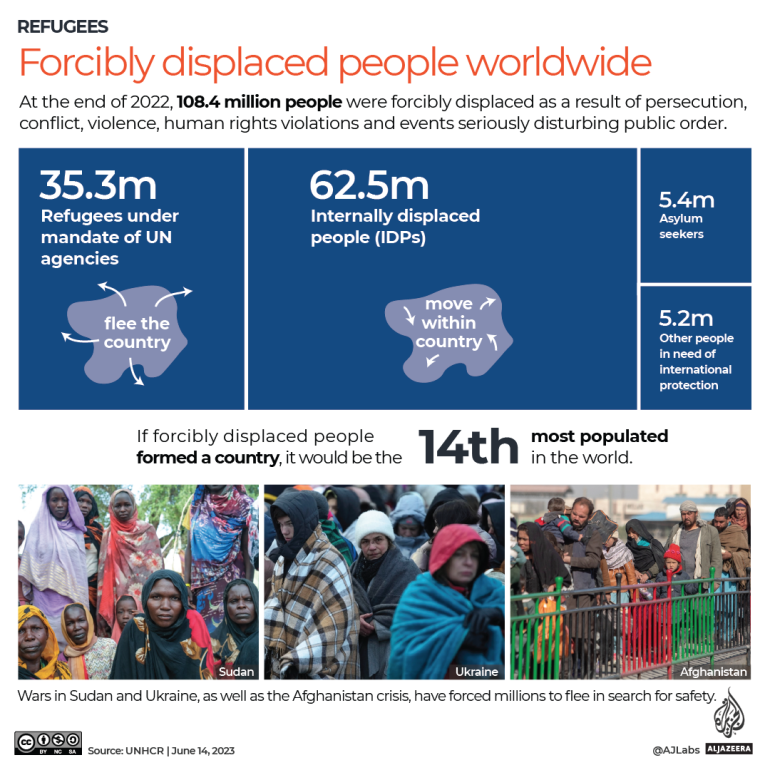The number of people displaced around the world has reached a record 110 million, with the wars in Ukraine and Sudan forcing millions from their homes.
In its flagship annual report, Global Trends in Forced Displacement 2022, the United Nations High Commissioner for Refugees (UNHCR) said the figure went up by more than 19 million compared with last year’s, the biggest ever increase.
Here are the key takeaways from the report that was published on Wednesday.
Refugee figure reaches 35.3 million
Out of the total number of people displaced, 35.3 million were refugees, or people who crossed an international border to find safety. under the mandate of UN agnecies. The greater share – 58 percent, representing 62.5 million people – were displaced in their home countries due to conflict and violence.
The total number of refugees worldwide rose by a record 35 per cent in 2022, driven by the conflict in Ukraine and revised estimates of Afghans in Iran and Pakistan. Turkey remained the country hosting the highest number of refugees in the world with 3.6 million refugees, over 10 percent of the total.
The upward trajectory in global forced displacement showed no sign of slowing in 2023 as the conflict in Sudan triggered new outflows.

Home beyond reach
For every refugee that managed to return home last year, 22 others became refugees.
Just 339,300 refugees were reported to have returned, while this remained beyond reach for most displacement situations around the world.
At the end of last year, 58 per cent of all forcibly displaced people remained in their own country. New internal displacements surged, with 28 million new displacements due to conflict and violence during the year.
War in Ukraine and conflicts in the Democratic Republic of the Congo, Ethiopia and Myanmar each displaced more than a million people within their own country.
A further 32.6 million new displacements were due to disasters, including climate-related events, with 21 percent occurring in the Least Developed Countries (LDC) and Small Island Developing States (SIDS), which experienced disproportionately high economic losses in relation to the size of their economies.
LDCs have been recognised as a category of states by the UN that are deemed highly disadvantaged in their development process, for structural, historical and also geographical reasons.
SIDS were recognised as a special case both for their environment and development at the 1992 United Nations Conference on Environment and Development.
Solutions to displacement
The UN listed durable solutions to include voluntary repatriation, local integration and resettlement to a third country.
The number of refugees resettled in 2022 doubled to reach 114,300, recovering to pre-COVID-19 pandemic levels.
This accounted for only a fraction of the projected 1.5 million refugees in need of resettlement. For each refugee that returned or was resettled in 2022, there were 16 new refugees.
The highest number of new applications was recorded in Pakistan (28,500), Egypt (27,300) and Libya (20,200).
In 2022, 339,300 refugees voluntarily returned to 38 countries of origin, a decrease of 90,000 or 21 percent compared with the previous year.
Some 51,300 Syrians returned to their country during the year, an increase of 14,800 from 2021, with two-thirds of the refugees returning from Turkey.
‘Too slow to find solutions’
The UNHCR has called for concerted action as armed conflict and climate-driven upheaval meant more people than ever remained uprooted from their homes last year.
“These figures show us that some people are far too quick to rush to conflict, and way too slow to find solutions. The consequence is devastation, displacement, and anguish for each of the millions of people forcibly uprooted from their homes,” UN High Commissioner for Refugees Filippo Grandi said.
“Above all, much more must be done to end conflict and remove obstacles so that refugees have the viable option to return home voluntarily, safely and with dignity.”
Jan Egeland, Secretary-General of the Norwegian Refugee Council, said: “This has been a dark decade. Every year, the world watches the number of displaced people increase, and then does too little to protect and assist the displaced. There is a reason for the dramatic increase in refugees and internally displaced: we fail to prevent war and violence, and national and international leaderships fail in conflict resolution where we have protracted emergencies.”
